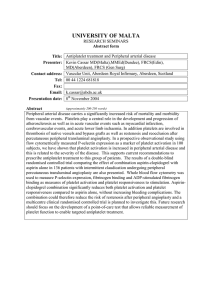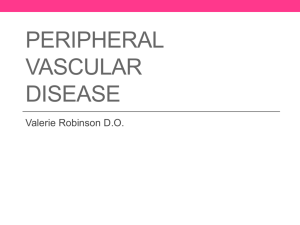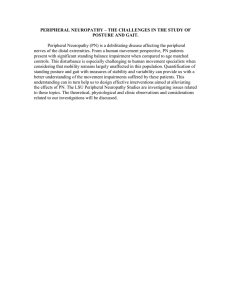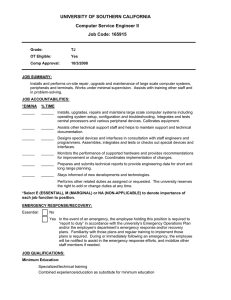Training Standards for Physicians Performing Peripheral Angioplasty and Other Percutaneous
advertisement
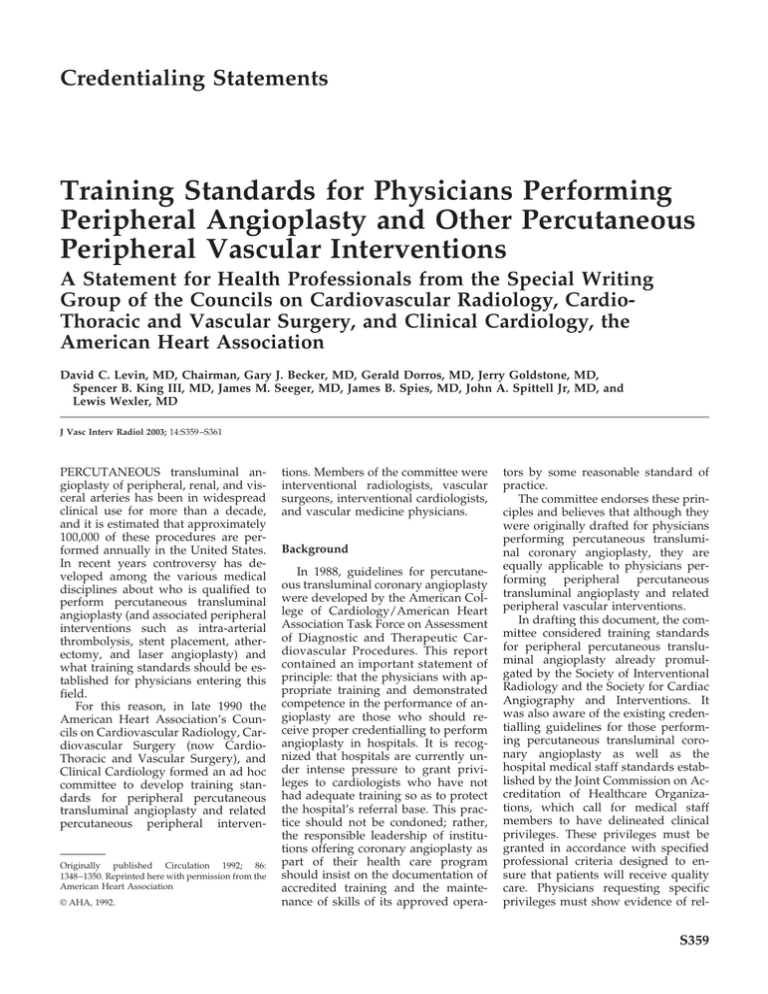
Credentialing Statements Training Standards for Physicians Performing Peripheral Angioplasty and Other Percutaneous Peripheral Vascular Interventions A Statement for Health Professionals from the Special Writing Group of the Councils on Cardiovascular Radiology, CardioThoracic and Vascular Surgery, and Clinical Cardiology, the American Heart Association David C. Levin, MD, Chairman, Gary J. Becker, MD, Gerald Dorros, MD, Jerry Goldstone, MD, Spencer B. King III, MD, James M. Seeger, MD, James B. Spies, MD, John A. Spittell Jr, MD, and Lewis Wexler, MD J Vasc Interv Radiol 2003; 14:S359 –S361 PERCUTANEOUS transluminal angioplasty of peripheral, renal, and visceral arteries has been in widespread clinical use for more than a decade, and it is estimated that approximately 100,000 of these procedures are performed annually in the United States. In recent years controversy has developed among the various medical disciplines about who is qualified to perform percutaneous transluminal angioplasty (and associated peripheral interventions such as intra-arterial thrombolysis, stent placement, atherectomy, and laser angioplasty) and what training standards should be established for physicians entering this field. For this reason, in late 1990 the American Heart Association’s Councils on Cardiovascular Radiology, Cardiovascular Surgery (now CardioThoracic and Vascular Surgery), and Clinical Cardiology formed an ad hoc committee to develop training standards for peripheral percutaneous transluminal angioplasty and related percutaneous peripheral interven- Originally published Circulation 1992; 86: 1348 –1350. Reprinted here with permission from the American Heart Association © AHA, 1992. tions. Members of the committee were interventional radiologists, vascular surgeons, interventional cardiologists, and vascular medicine physicians. Background In 1988, guidelines for percutaneous transluminal coronary angioplasty were developed by the American College of Cardiology/American Heart Association Task Force on Assessment of Diagnostic and Therapeutic Cardiovascular Procedures. This report contained an important statement of principle: that the physicians with appropriate training and demonstrated competence in the performance of angioplasty are those who should receive proper credentialling to perform angioplasty in hospitals. It is recognized that hospitals are currently under intense pressure to grant privileges to cardiologists who have not had adequate training so as to protect the hospital’s referral base. This practice should not be condoned; rather, the responsible leadership of institutions offering coronary angioplasty as part of their health care program should insist on the documentation of accredited training and the maintenance of skills of its approved opera- tors by some reasonable standard of practice. The committee endorses these principles and believes that although they were originally drafted for physicians performing percutaneous transluminal coronary angioplasty, they are equally applicable to physicians performing peripheral percutaneous transluminal angioplasty and related peripheral vascular interventions. In drafting this document, the committee considered training standards for peripheral percutaneous transluminal angioplasty already promulgated by the Society of Interventional Radiology and the Society for Cardiac Angiography and Interventions. It was also aware of the existing credentialling guidelines for those performing percutaneous transluminal coronary angioplasty as well as the hospital medical staff standards established by the Joint Commission on Accreditation of Healthcare Organizations, which call for medical staff members to have delineated clinical privileges. These privileges must be granted in accordance with specified professional criteria designed to ensure that patients will receive quality care. Physicians requesting specific privileges must show evidence of rel- S359 S360 • Training Standards for Performing Peripheral Angioplasty evant training or experience as well as current competence. To ensure that physicians performing percutaneous transluminal angioplasty of the peripheral, renal, and other visceral vessels (hereafter collectively referred to as “peripheral” vessels) are qualified, a minimum level of training and/or experience must be documented before privileges are granted. These training standards are intended to help medical institutions determine whether to grant initial privileges for peripheral percutaneous transluminal angioplasty and should be used when reviewing applications from physicians regardless of their specialty. Training Standards Body of Knowledge Physician applicants should have extensive clinical training in the diagnosis and treatment of patients with peripheral vascular disease. The body of knowledge necessary includes the anatomy, natural history, and clinical manifestations of peripheral vascular disease; noninvasive assessment of peripheral vascular disease; indications and contraindications for angioplasty; risks and benefits of angioplasty; recognition of complications; alternative therapies; principles of thrombolytic techniques; and technical aspects and usage of x-ray equipment needed for diagnostic peripheral angiography and percutaneous transluminal angioplasty. Definitions For the purposes of these standards, a diagnostic angiogram is defined as the percutaneous passage of a catheter into an artery under fluoroscopic guidance with subsequent injection of contrast material and imaging of the entire vascular distribution in question using conventional serial film changers or large field digital imaging systems. For example, peripheral angiography of lower-extremity vessels must image the vessels of both lower extremities from the distal aorta to at least the ankles. Conventional cineradiography or videofluoroscopy alone is not sufficient for the routine recording of peripheral angiographic studies. Measurements of intra-arterial pressure gradients are a useful adjunct and may be necessary to fully assess the significance of vascular occlusive disease as well as the outcome of an interventional procedure. Angioplasty is defined here as a percutaneous transluminal balloon dilation procedure or similar procedure using an artherectomy, stent, or other interventional device. Such a procedure would generally involve percutaneous vascular access, transluminal passage of a balloon catheter or other interventional device, and treatment at the appropriate sites. The angioplasty procedure includes angiographic and hemodynamic documentation of the result and appropriate clinical follow-up during the patient’s hospitalization. Basic Training A basic training requirement must be met by each physician applicant and should include at least one of the following: American Board of Radiology eligibility or certification American Board of Internal Medicine eligibility or certification with additional completion of a fellowship in vascular medicine or American Board of Internal Medicine certification with additional eligibility or certification in cardiovascular medicine American Board of Surgery eligibility or certification with additional completion of a general vascular surgery residency. Specific Procedural Training and Experience Specific training or experience in peripheral diagnostic angiography and peripheral percutaneous transluminal angioplasty is required. This may be obtained through one of the following: 1. Qualification by Training An applicant may qualify by completing a training program that includes extensive experience in diagnostic angiography and percutaneous transluminal angioplasty of peripheral vessels. At a minimum, this experience must include performance of 100 diagnostic peripheral angiograms and 50 renal and/or peripheral percutaneous transluminal angioplasty, and for September 2003 JVIR at least half of these procedures the applicant must be primary operator. In addition, the applicant should have training and experience in the use of thrombolytic therapy in peripheral arteries, having participated in 10 such cases. These requirements would normally be met during a formal subspecialty training program of at least one year’s duration, completed after at least one of the basic training requirements listed in the previous section has been met. However, they may be met in part or in total during initial residency or fellowship. In all instances, complete and detailed documentation of the aforementioned procedural training should be available. 2. Qualification of Experience An applicant may qualify by having extensive previous experience in peripheral angiographic diagnosis and percutaneous transluminal angioplasty with acceptable complication and success rates. This experience must include performance of a minimum of 100 diagnostic angiograms and 50 percutaneous transluminal angioplasties of the peripheral arteries, and for at least half of these procedures, the applicant must be primary operator. The applicant should have experience in the use of thrombolytic therapy in peripheral arteries, having participated in at least 10 such cases. The applicant should be able to present documentation of results and complications, and confirmation of this data may be requested from the institution where the experience was gained. 3. Qualification of Apprenticeship These physicians must be prepared to demonstrate knowledge of the principles of diagnosis and therapy of peripheral and visceral vascular disease, as outlined in “Body of Knowledge.” Clear understanding of the method of diagnostic angiography must be demonstrated, including knowledge of appropriate radiographic equipment, catheters and catheter techniques, and radiation safety associated with diagnostic and interventional procedures. The apprenticeship should be thoroughly documented and should include each of the following as a minimum: Volume 14 Number 9 Part 2 Documented performance of 100 diagnostic peripheral angiograms, 50 peripheral percutaneous transluminal angioplasty procedures, and 10 peripheral arterial thrombolysis procedures under the direct supervision of a qualified physician preceptor. The applicant must have been the primary operator for at least half of these procedures. The requirement for the diagnostic angiograms may be met in part by the previous experience of the operator if appropriate records are submitted (as outlined in “Qualification by Experience”). Observation of the applicant performing at least 10 peripheral percutaneous transluminal angioplasties by a person already qualified by these standards. Attendance at postgraduate courses for a total of at least 50 Category 1 Continuing Medical Education credits Levin et al in diagnostic peripheral angiography and percutaneous peripheral vascular interventional techniques. Maintenance of Privileges Maintenance of percutaneous transluminal angioplasty privileges requires ongoing experience in performing these procedures with acceptable success and complication rates. The determination of a minimum number of procedures per year is at the discretion of the credentials or clinical privileges committee of each hospital. Whether or not a minimum number is specified, maintenance of privileges is also dependent on the physician’s active participation in the institution’s quality improvement program that monitors indications, success rates, and complications. This data may be • S361 used within the individual institution in considering renewal of clinical privileges. All physicians performing these procedures must participate in the quality improvement program and will be evaluated using the same criteria. Physicians who were granted privileges before the implementation of this standard should not necessarily have their status altered if they do not meet the qualifications outlined in this statement. However, if they do not meet those qualifications, they should acquire necessary training or experience to do so within 3 years. They must also participate in the institution’s quality improvement program and will be evaluated using the same standard for indications, success rates, and complications.

